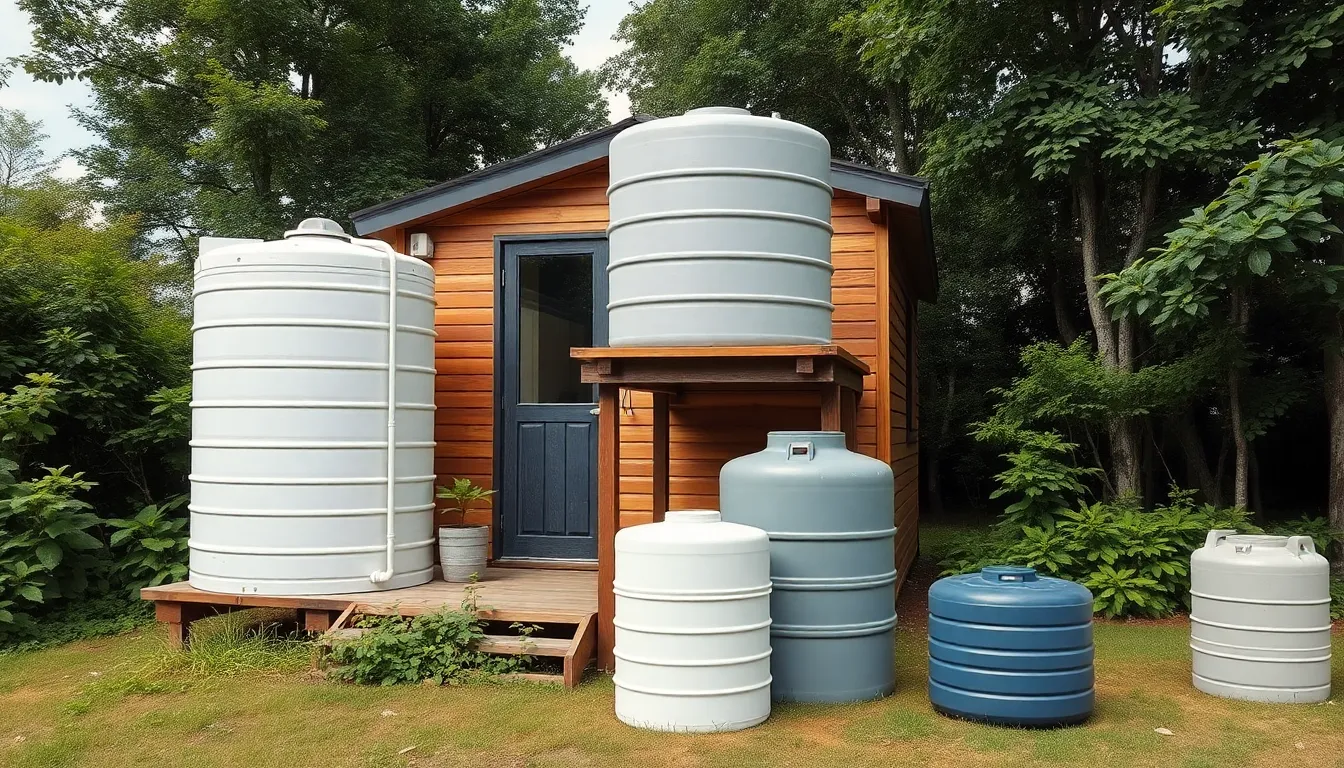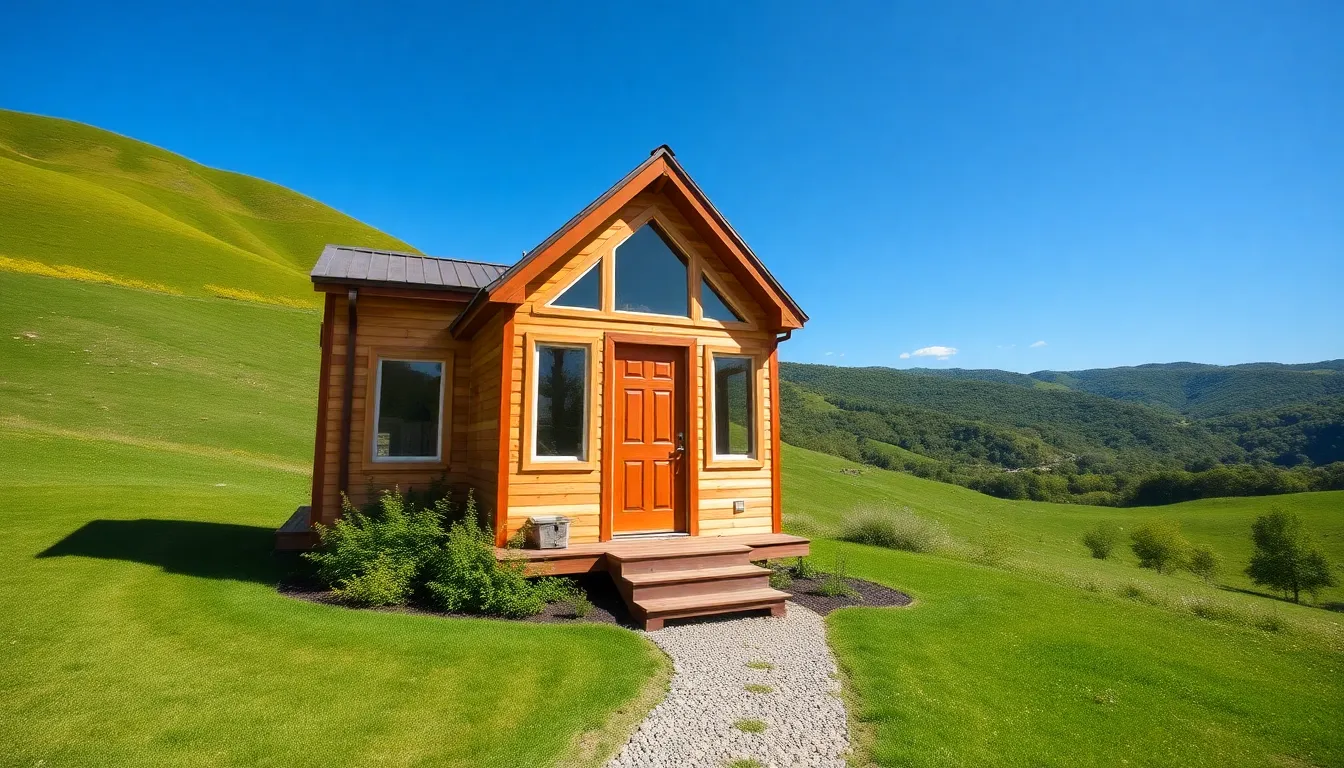Tiny homes are all the rage, but what about their water supply? Enter tiny home water tanks—the unsung heroes of the minimalist lifestyle. These compact wonders are designed to fit snugly into the smallest of spaces, ensuring you don’t have to sacrifice your morning shower for square footage. Who knew a little tank could hold so much potential?
Imagine enjoying a refreshing drink straight from your own water source, all while keeping your footprint as small as your home. With options that range from sleek and stylish to downright quirky, these water tanks are not just functional; they can also be a conversation starter. So why not give your tiny home the hydration it deserves? After all, even the tiniest of dwellings need a reliable water supply to keep life flowing smoothly.
Table of Contents
ToggleOverview of Tiny Home Water Tanks
Tiny home water tanks serve as vital components of the water supply system in compact living spaces. Designed with space efficiency in mind, these tanks fit snugly into corners or beneath furniture, maximizing functionality without consuming valuable square footage. Utility and aesthetics combine, allowing homeowners to choose tanks that complement their interior designs.
In terms of capacity, tiny home water tanks typically hold between 20 to 100 gallons. This range accommodates various needs, from simple showering to basic cooking and cleaning tasks. Rainwater collection systems often integrate with these tanks, promoting sustainability by utilizing natural resources.
Installation options vary; many homeowners prefer external tanks to save interior space, while others opt for built-in solutions. The choice often depends on the layout of the tiny home and individual lifestyle preferences. Easy maintenance is another feature, as most tanks require minimal upkeep to ensure water quality and longevity.
Materials used for these tanks play a significant role in durability. Commonly, options include polyethylene, stainless steel, and fiberglass, providing resilience against leaks or punctures. Manufacturers often design these tanks to withstand various environmental conditions.
Safety features are essential, too. Many tanks come equipped with UV filters or purification systems, ensuring clean drinking water. Implementing these systems can significantly enhance the quality and safety of the water supply.
Tiny home water tanks embody the essence of sustainable living. They make modern conveniences available in minimalist environments, supporting a lifestyle that values both functionality and sustainability. Homeowners can select from diverse styles and sizes, making it easy to find the perfect fit for their unique homes.
Types of Tiny Home Water Tanks
Tiny home water tanks come in several varieties, each tailored for different needs and preferences. Understanding these types helps owners choose the right solution for their compact living spaces.
Pressure Tanks
Pressure tanks are designed to maintain consistent water pressure throughout the plumbing system. Often made from durable materials like steel, these tanks can store 20 to 100 gallons of water. By using a pressure switch, they automatically refill when the water level drops. This system ensures a reliable water supply for showers and appliances, making it a popular choice among tiny home dwellers.
Gravity Tanks
Gravity tanks utilize the natural force of gravity to distribute water. Typically located at a higher elevation, gravity tanks create water pressure without requiring pumps. These tanks are often built from materials like polyethylene or fiberglass, providing longevity and resistance to corrosion. A capacity of up to 150 gallons can serve multiple fixtures effectively. Gravity systems offer simplicity and lower energy consumption, appealing to environmentally conscious homeowners.
Portable Tanks
Portable tanks provide flexibility for tiny home owners. These tanks come in various sizes, from small 5-gallon containers to larger options holding up to 150 gallons. Made from lightweight materials, they can easily be moved for refills or during travel. Portable tanks are especially useful for those who frequently relocate their homes or prefer a temporary solution. Additionally, these tanks facilitate rainwater harvesting for sustainable living practices.
Benefits of Using Tiny Home Water Tanks
Tiny home water tanks offer several advantages that cater to modern living. They enhance water accessibility while promoting a minimalist lifestyle.
Space Efficiency
Compact designs make tiny home water tanks ideal for limited spaces. These tanks fit seamlessly into tiny homes, ensuring that no additional square footage is sacrificed. Homeowners often select locations like under sinks or in cabinets, utilizing every inch effectively. Many water tanks come in various sizes, typically ranging from 20 to 100 gallons, providing flexibility according to specific needs. Some units can even integrate with existing fixtures, streamlining overall design and function. Efficient use of space ultimately leads to maximized interior functionality while still providing essential water availability.
Cost-Effectiveness
Investing in tiny home water tanks presents a financially viable option. Lower upfront costs typically align with the overall budget-friendly philosophy of tiny living. Homeowners reduce water bills by storing rainwater or utilizing pressure tanks, which maintain consistent water pressure with minimal energy consumption. Long-term maintenance costs remain manageable due to durable materials like polyethylene and stainless steel. Without the need for extensive plumbing or large-scale infrastructure, expenses stay low. Overall, tiny home water tanks represent a practical solution for those seeking affordability without sacrificing quality.
Environmental Impact
Embracing tiny home water tanks significantly benefits the environment. These tanks often support rainwater harvesting, reducing reliance on municipal water supplies. Sustainable living becomes more achievable when homeowners implement eco-friendly practices, such as filtering and purifying collected rainwater. A decrease in water waste accompanies this lifestyle choice, supporting conservation efforts. Additionally, the durable materials used generally have lower environmental footprints, further aligning with green initiatives. Ultimately, tiny home water tanks foster responsible resource use, aligning perfectly with the values of sustainability and minimalism.
Considerations When Choosing Tiny Home Water Tanks
Selecting the right tiny home water tank involves multiple factors. One key consideration is the size and capacity of the tank.
Size and Capacity
Determining the appropriate size depends on water needs and available space. Tanks typically hold between 20 to 100 gallons, accommodating different usage levels. Homeowners should evaluate daily consumption rates when deciding on capacity. Smaller tanks suit minimal usage, while larger tanks better serve households with greater demands. Assessing space availability becomes essential, as compact designs fit snugly in tiny homes.
Material Durability
Choosing the right material significantly impacts longevity. Options like polyethylene, stainless steel, and fiberglass present various durability levels. Polyethylene offers lightweight, corrosion-resistant benefits, while stainless steel provides strength and a sleek appearance. Fiberglass combines strength and insulation, making it ideal for temperature fluctuations. Homeowners must consider the environment in which their tank will reside, as particular materials perform better in specific conditions.
Maintenance Requirements
Consistent maintenance ensures optimal tank performance and water quality. Regular cleaning and inspections help prevent sediment buildup and contamination. Many tanks require filter replacements to maintain safe drinking water. Additionally, homeowners should address any leaks promptly to minimize damage. Understanding specific maintenance needs associated with each tank type supports informed decision-making. Prioritizing these tasks fosters long-term functionality and durability in tiny home water systems.
Conclusion
Tiny home water tanks play a crucial role in enhancing the functionality and sustainability of compact living spaces. By offering reliable water supply solutions, these tanks allow homeowners to enjoy essential amenities without sacrificing precious space. Their diverse designs cater to various needs and preferences, ensuring that every tiny home can find a suitable option.
With the right choice of tank, homeowners can embrace a minimalist lifestyle while maintaining access to clean water. This balance of practicality and style not only supports daily living but also aligns with the values of conservation and efficiency. Ultimately, tiny home water tanks are an indispensable part of modern sustainable living, making it easier for individuals to thrive in their smaller spaces.







